Page 259 of 498
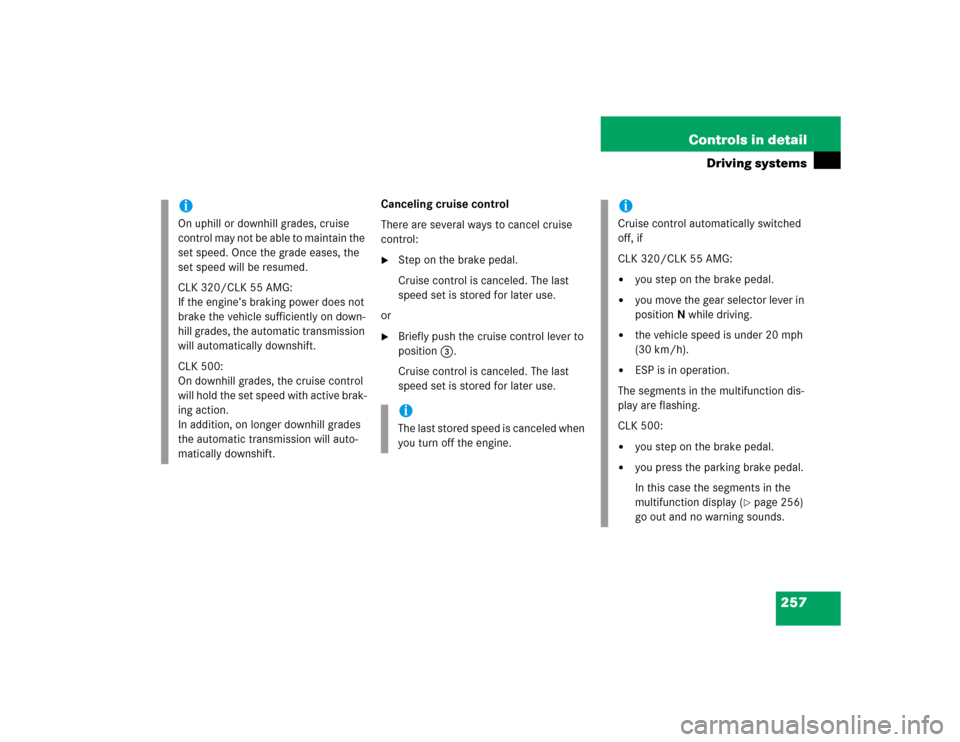
257 Controls in detail
Driving systems
Canceling cruise control
There are several ways to cancel cruise
control:�
Step on the brake pedal.
Cruise control is canceled. The last
speed set is stored for later use.
or
�
Briefly push the cruise control lever to
position3.
Cruise control is canceled. The last
speed set is stored for later use.
iOn uphill or downhill grades, cruise
control may not be able to maintain the
set speed. Once the grade eases, the
set speed will be resumed.
CLK 320/CLK 55 AMG:
If the engine’s braking power does not
brake the vehicle sufficiently on down-
hill grades, the automatic transmission
will automatically downshift.
CLK 500:
On downhill grades, the cruise control
will hold the set speed with active brak-
ing action.
In addition, on longer downhill grades
the automatic transmission will auto-
matically downshift.
iThe last stored speed is canceled when
you turn off the engine.
iCruise control automatically switched
off, if
CLK 320/CLK 55 AMG:�
you step on the brake pedal.
�
you move the gear selector lever in
positionN while driving.
�
the vehicle speed is under 20 mph
(30 km/h).
�
ESP is in operation.
The segments in the multifunction dis-
play are flashing.
CLK 500:
�
you step on the brake pedal.
�
you press the parking brake pedal.
In this case the segments in the
multifunction display (
�page 256)
go out and no warning sounds.
Page 260 of 498
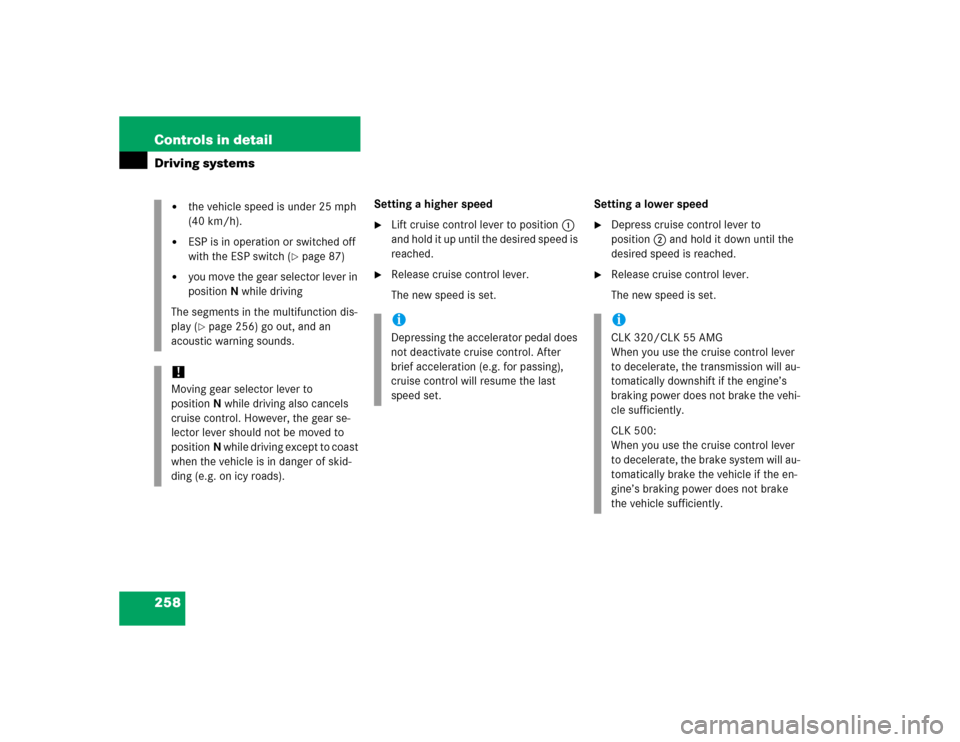
258 Controls in detailDriving systems
Setting a higher speed�
Lift cruise control lever to position1
and hold it up until the desired speed is
reached.
�
Release cruise control lever.
The new speed is set.Setting a lower speed
�
Depress cruise control lever to
position2 and hold it down until the
desired speed is reached.
�
Release cruise control lever.
The new speed is set.
�
the vehicle speed is under 25 mph
(40 km/h).
�
ESP is in operation or switched off
with the ESP switch (
�page 87)
�
you move the gear selector lever in
positionN while driving
The segments in the multifunction dis-
play (�page 256) go out, and an
acoustic warning sounds.
!Moving gear selector lever to
positionN while driving also cancels
cruise control. However, the gear se-
lector lever should not be moved to
positionN while driving except to coast
when the vehicle is in danger of skid-
ding (e.g. on icy roads).
iDepressing the accelerator pedal does
not deactivate cruise control. After
brief acceleration (e.g. for passing),
cruise control will resume the last
speed set.
iCLK 320/CLK 55 AMG
When you use the cruise control lever
to decelerate, the transmission will au-
tomatically downshift if the engine’s
braking power does not brake the vehi-
cle sufficiently.
CLK 500:
When you use the cruise control lever
to decelerate, the brake system will au-
tomatically brake the vehicle if the en-
gine’s braking power does not brake
the vehicle sufficiently.
Page 278 of 498
276 Controls in detailUseful featuresAshtrays
Center console ashtray
1Cover plate
2Sliding button
3Ashtray insert
Opening ashtray�
Briefly press the bottom of cover
plate1.
The cover plate opens automatically.Removing ashtray insert
�
Secure vehicle from movement by
setting the parking brake.
�
Move the gear selector lever to
positionN.
Now you have more room to take out
the insert.
�
Push sliding button2 to the right.
The ashtray is disengaged and slides a
short way in direction of arrow3.
�
Remove the ashtray insert.Reinstalling the ashtray insert
�
Push the ashtray insert 3 down into
the retainer until it engages.
�
Push down cover plate 1 to close the
ashtray.
The cover plate engages.
Rear seat ashtray
1Button
2Ashtray insert
3Cover
Warning!
G
Remove front ashtray only with vehicle
standing still. Set the parking brake to se-
cure vehicle from movement. Move gear se-
lector lever to positionN. With gear selector
lever in positionN, turn off the engine.
Page 281 of 498
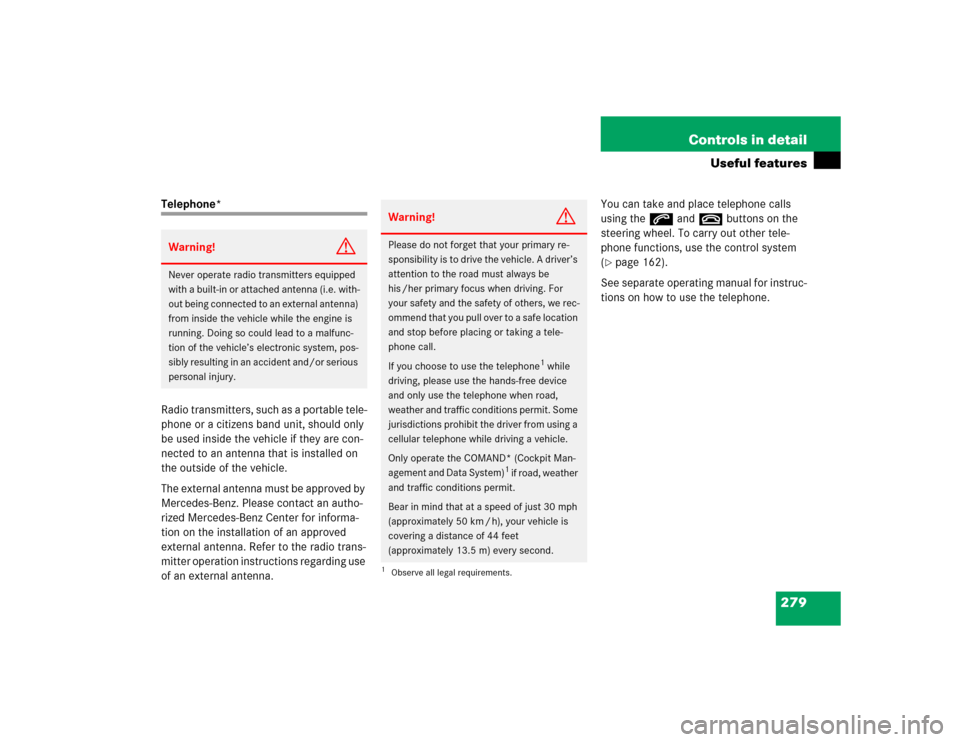
279 Controls in detail
Useful features
Telephone*
Radio transmitters, such as a portable tele-
phone or a citizens band unit, should only
be used inside the vehicle if they are con-
nected to an antenna that is installed on
the outside of the vehicle.
The external antenna must be approved by
Mercedes-Benz. Please contact an autho-
rized Mercedes-Benz Center for informa-
tion on the installation of an approved
external antenna. Refer to the radio trans-
mitter operation instructions regarding use
of an external antenna.You can take and place telephone calls
using thes andt buttons on the
steering wheel. To carry out other tele-
phone functions, use the control system
(
�page 162).
See separate operating manual for instruc-
tions on how to use the telephone.
Warning!
G
Never operate radio transmitters equipped
with a built-in or attached antenna (i.e. with-
out being connected to an external antenna)
from inside the vehicle while the engine is
running. Doing so could lead to a malfunc-
tion of the vehicle’s electronic system, pos-
sibly resulting in an accident and/or serious
personal injury.
Warning!
G
Please do not forget that your primary re-
sponsibility is to drive the vehicle. A driver’s
attention to the road must always be
his /her primary focus when driving. For
your safety and the safety of others, we rec-
ommend that you pull over to a safe location
and stop before placing or taking a tele-
phone call.
If you choose to use the telephone
1 while
driving, please use the hands-free device
and only use the telephone when road,
weather and traffic conditions permit. Some
jurisdictions prohibit the driver from using a
cellular telephone while driving a vehicle.
Only operate the COMAND* (Cockpit Man-
agement and Data System)
1 if road, weather
and traffic conditions permit.
Bear in mind that at a speed of just 30 mph
(approximately 50 km / h), your vehicle is
covering a distance of 44 feet
(approximately 13.5 m) every second.
1Observe all legal requirements.
Page 295 of 498
293 Operation
The first 1 000 miles (1 500 km)
Driving instructions
At the gas station
Engine compartment
Tires and wheels
Winter driving
Maintenance
Vehicle care
Page 296 of 498

294 OperationIn the “Operation” section you will find
detailed information on operating,
maintaining and caring for your vehicle.The first 1 000 miles (1 500 km)
The more cautiously you treat your vehicle
during the break-in period, the more satis-
fied you will be with its performance later
on.�
Drive your vehicle during the first
1 000 miles (1 500 km) at varying but
moderate vehicle and engine speeds.
�
During this period, avoid heavy loads
(full throttle driving) and excessive
engine speeds (no more than
2/3 of
maximum rpm in each gear).
�
Shift gears in a timely manner.
�
Avoid accelerating by kickdown.
�
Do not attempt to slow the vehicle
down by shifting to a lower gear using
the gear selector lever.
�
Select positions3,2or1 only when
driving at moderate speeds (for hill
driving).
�
Select modeC as the preferred shift
program (
�page 170) for the first
1 000 miles (1 500 km).After 1 000 miles (1 500 km), you may
gradually increase vehicle and engine
speeds to the permissible maximum.
All of the above instructions, as may apply
to your vehicle type, also apply when
driving the first 1 000 miles (1 500 km)
after the engine or the rear differential has
been replaced.
!Additional instructions for AMG
vehicles:�
During the first 1 000 miles
(1 500 km), do not exceed a speed
of 85 mph (140 km / h).
�
During this period, avoid engine
speeds above 4 500 rpm in each
gear.
iAlways obey applicable speed limits.
Page 297 of 498
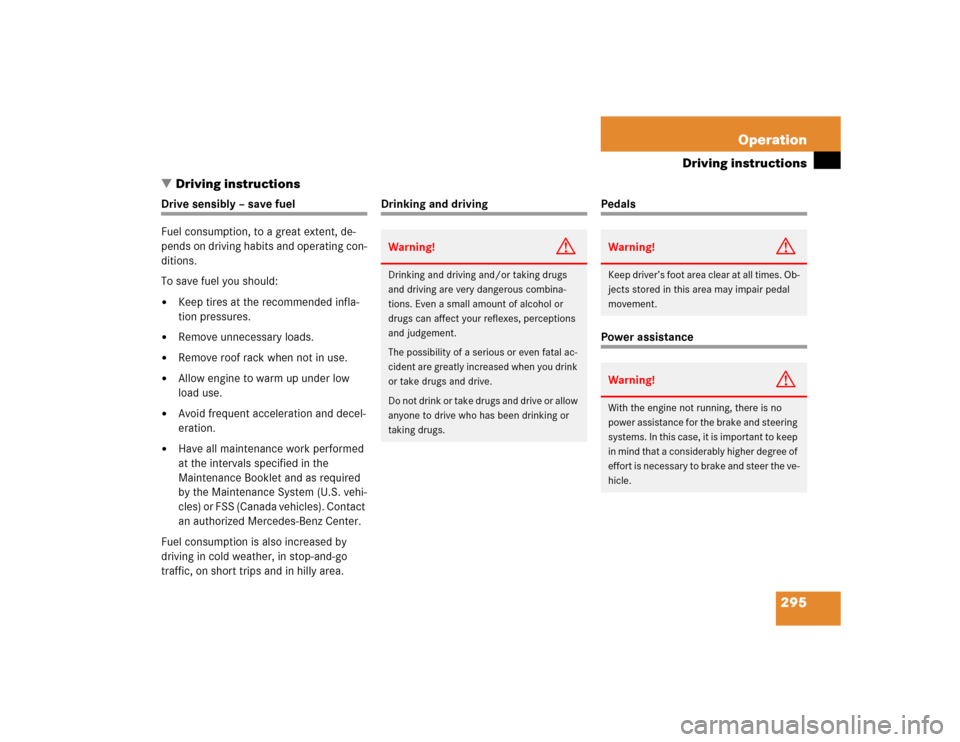
295 Operation
Driving instructions
�Driving instructions
Drive sensibly – save fuel
Fuel consumption, to a great extent, de-
pends on driving habits and operating con-
ditions.
To save fuel you should:�
Keep tires at the recommended infla-
tion pressures.
�
Remove unnecessary loads.
�
Remove roof rack when not in use.
�
Allow engine to warm up under low
load use.
�
Avoid frequent acceleration and decel-
eration.
�
Have all maintenance work performed
at the intervals specified in the
Maintenance Booklet and as required
by the Maintenance System (U.S. vehi-
cles) or FSS (Canada vehicles). Contact
an authorized Mercedes-Benz Center.
Fuel consumption is also increased by
driving in cold weather, in stop-and-go
traffic, on short trips and in hilly area.
Drinking and driving
PedalsPower assistance
Warning!
G
Drinking and driving and/or taking drugs
and driving are very dangerous combina-
tions. Even a small amount of alcohol or
drugs can affect your reflexes, perceptions
and judgement.
The possibility of a serious or even fatal ac-
cident are greatly increased when you drink
or take drugs and drive.
Do not drink or take drugs and drive or allow
anyone to drive who has been drinking or
taking drugs.
Warning!
G
Keep driver’s foot area clear at all times. Ob-
jects stored in this area may impair pedal
movement.Warning!
G
With the engine not running, there is no
power assistance for the brake and steering
systems. In this case, it is important to keep
in mind that a considerably higher degree of
effort is necessary to brake and steer the ve-
hicle.
Page 299 of 498
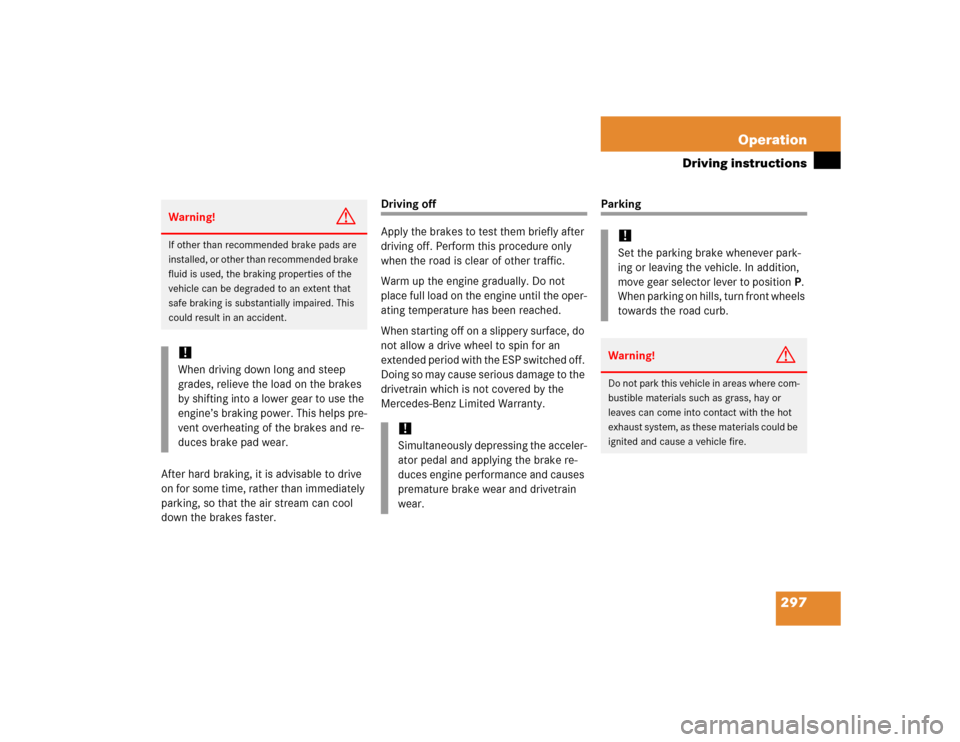
297 Operation
Driving instructions
After hard braking, it is advisable to drive
on for some time, rather than immediately
parking, so that the air stream can cool
down the brakes faster.
Driving off
Apply the brakes to test them briefly after
driving off. Perform this procedure only
when the road is clear of other traffic.
Warm up the engine gradually. Do not
place full load on the engine until the oper-
ating temperature has been reached.
When starting off on a slippery surface, do
not allow a drive wheel to spin for an
extended period with the ESP switched off.
Doing so may cause serious damage to the
drivetrain which is not covered by the
Mercedes-Benz Limited Warranty.
Parking
Warning!
G
If other than recommended brake pads are
installed, or other than recommended brake
fluid is used, the braking properties of the
vehicle can be degraded to an extent that
safe braking is substantially impaired. This
could result in an accident.!When driving down long and steep
grades, relieve the load on the brakes
by shifting into a lower gear to use the
engine’s braking power. This helps pre-
vent overheating of the brakes and re-
duces brake pad wear.
!Simultaneously depressing the acceler-
ator pedal and applying the brake re-
duces engine performance and causes
premature brake wear and drivetrain
wear.
!Set the parking brake whenever park-
ing or leaving the vehicle. In addition,
move gear selector lever to positionP.
When parking on hills, turn front wheels
towards the road curb.Warning!
G
Do not park this vehicle in areas where com-
bustible materials such as grass, hay or
leaves can come into contact with the hot
exhaust system, as these materials could be
ignited and cause a vehicle fire.